 Sheepwagon (also called sheepcamp) built In Wyoming circa 1885. This wagon was originally purchased by a sheep rancher in Utah where it was found, bought by the Meeker Classic Committee, and restored for a permanent indoor display at the Meeker White River Museum. Restoration work was done by Leonard Thompson (the driver in the photos).
Sheepwagon (also called sheepcamp) built In Wyoming circa 1885. This wagon was originally purchased by a sheep rancher in Utah where it was found, bought by the Meeker Classic Committee, and restored for a permanent indoor display at the Meeker White River Museum. Restoration work was done by Leonard Thompson (the driver in the photos).
The sheepwagon is displayed for local events, like the Meeker Classic dog trials, and used in the Meeker Fourth of July parade. Look for the historic Sheepwagon while visiting the 2013 Meeker Sheepdog Classic dog trials.
James Candlish, a blacksmith from Rawlins, Wyoming is credited with building the first sheepwagon in 1884. The efficient interior configuration evolved from English, European, and military antecedents, including the living areas on sailing vessels. The standard design is 11 feet long and 6-1/2 feet wide, enclosed by a canvas top, with a stove for heat and cooking. The interior boasts well-designed storage places. Compact beds are tucked away. Tables fold down when not in use. Everything has its place. The interior configuration has proved so efficient that the same basic plan is still used in the sheepwagons made today and has served as a model for many modern campers.
During earlier years in the American west, millions of sheep were grazed on the rangelands. A lone herder and his dogs could tend a couple of thousand sheep. The sheepwagon was the herder’s mobile home as he followed these bands. During the seasonal grazing cycles, sheep were often moved hundreds of miles. A camptender delivered supplies every ten days or so, and was often the herder’s only contact with the outside world for months at a time.
In the Meeker area, sheepwagons and herders with their dogs and horses are still common. We do see innovations such as solar panels to provide power to the TVs and other modern conveniences.After World War II, sheep ranchers began to fence their large tracts of private land and left more sheep without a herder. The pick up truck replaced the teams of horses that pulled the wagon. The rancher could more easily check flocks in new four-wheel drive vehicles. Semi trucks and trailers, in many cases, began to move the bands from summer to winter pastures.
 WILSON SHEEPCAMPS
WILSON SHEEPCAMPS
For three generations the Wilson family from Midway, Utah has been passionate about building high quality sheepcamps. The first Wilson Sheepcamp was built in 1976 to use on the family ranch. The Wilson Family saw the need to build a sheepcamp that could travel at high rates of speed on the highway but is also capable of handling the rough Rocky Mountain roads. Wilson Sheepcamps strive to construct the best quality while keeping the cost affordable on the standard camp, however they also offer many custom options for a truly unique product. As well Wilson Sheepcamps are constantly improving their product with new technology and creative ideas. The Meeker Classic has been proud to have Wilson Sheepcamps on display at the trails since 2009. We encourage you to visit the Wilson Camps display at the 2011 Meeker Classic located just above the ditch in the middle of the food vending area.
Visit Wilson Sheepcamps online at:www.campwagons.com
